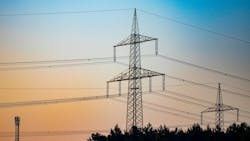Coming into contact with an overhead power line is a preventable safety incident. When it’s not prevented, the consequences are usually fatal. Informative Annex N provides an example of an industrial procedure for working around overhead electrical lines and equipment.
The example procedure is preceded by a short introduction [N.1] that covers important principles and concepts. An important principle is you should always assume the lines are hot and operating at over 1,000V. An important concept is that as the voltage increases, so also do the minimum working distances and the potential for arc-over.
Six requirements are stated in N.2. One of these is that employees be informed of the hazards and cautions when working near overhead lines. Another is that a spotter be assigned when someone is operating equipment near overhead lines. The spotter is responsible for observing safe working clearances around all overhead lines and directing the operator accordingly.
All employees and contractors must follow this procedure [N.3]. Because most company and contractor employees are not qualified to determine the system voltage level, a qualified person shall be called to determine voltages and clearances, and then take appropriate action to make the work zone safe.
The meat of Annex N is in N.4, which is divided into six subsections:
N.4.1, general requirements. This consists of four paragraphs. Notably, all electrical contact incidents, including “near misses” shall be reported to the local health and safety specialist.
N.4.2, look up and live flags. This subsection provides a few requirements for this life-saving safety item. These flags are used to indicate whether lifts, cranes, etc. are in use or have been returned to the “stowed or cradled” position.
N.4.3, high risk tasks. This addresses heavy mobile equipment, aerial lifts (and cranes and boom devices), and tree work.
N.4.4, underground electrical lines and equipment. This briefly addresses the requirement that you contact the local USA Dig service (call 811 or go online) and what to do if there isn’t one.
N.4.5, vehicles whose loads exceed 4.25 meters (14 feet) in height. This has six requirements. One of them is that an electrician, electrical construction representative, or qualified electrical contractor should check the intended route to the next location before actually taking that route.
N.4.6. emergency response. This enumerates eleven steps to take if an overhead power line falls or is contacted. The first is to keep everyone at least 10 feet away. The second one is to use flagging to warn people and help protect them from fallen or low wires.
About the Author

Mark Lamendola
Mark is an expert in maintenance management, having racked up an impressive track record during his time working in the field. He also has extensive knowledge of, and practical expertise with, the National Electrical Code (NEC). Through his consulting business, he provides articles and training materials on electrical topics, specializing in making difficult subjects easy to understand and focusing on the practical aspects of electrical work.
Prior to starting his own business, Mark served as the Technical Editor on EC&M for six years, worked three years in nuclear maintenance, six years as a contract project engineer/project manager, three years as a systems engineer, and three years in plant maintenance management.
Mark earned an AAS degree from Rock Valley College, a BSEET from Columbia Pacific University, and an MBA from Lake Erie College. He’s also completed several related certifications over the years and even was formerly licensed as a Master Electrician. He is a Senior Member of the IEEE and past Chairman of the Kansas City Chapters of both the IEEE and the IEEE Computer Society. Mark also served as the program director for, a board member of, and webmaster of, the Midwest Chapter of the 7x24 Exchange. He has also held memberships with the following organizations: NETA, NFPA, International Association of Webmasters, and Institute of Certified Professional Managers.
